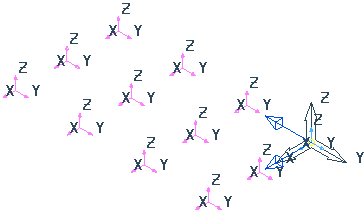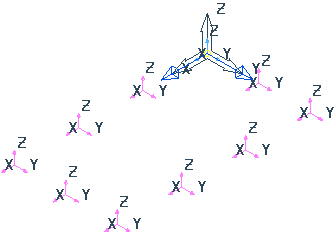Multiple Transform is an easier method of performing multiple Move or Rotate transformations to a workplane.
To display the Multiple Transform dialog click Workplane Transform tab > Transform panel > Multiple.
 ,
,  , or
, or  , set in the Information toolbar.
, set in the Information toolbar.For information on the Circular tab, see Multiple transform — Circular.
The Rectangular tab contains the following:
 Number of rows — Enter a value or use
Number of rows — Enter a value or use 
 to specify the number of rows.
to specify the number of rows.
This workplane transform has 3 rows and 4 columns:

 Distance between rows — Enter the distance between one instance and the next.
Distance between rows — Enter the distance between one instance and the next.
 Rotate axis — Click to rotate the transform by 90
Rotate axis — Click to rotate the transform by 90 in a clockwise direction in the principal working plane.
in a clockwise direction in the principal working plane.
For example, this option converts this:

to this:

 Workplane origin — When selected, the active workplane is the origin. If no workplane is active then the global coordinate system is the origin.
Workplane origin — When selected, the active workplane is the origin. If no workplane is active then the global coordinate system is the origin.
 Bounding box origin — When selected, the origin is the centre of the bounding box containing all the entities.
Bounding box origin — When selected, the origin is the centre of the bounding box containing all the entities.
 Move origin — When selected, you can move the origin graphically by dragging or by entering coordinates using
Move origin — When selected, you can move the origin graphically by dragging or by entering coordinates using  ,
,  , or
, or  and
and  in the Status bar.
in the Status bar.
 Distance between columns — Enter the distance between one instance and the next.
Distance between columns — Enter the distance between one instance and the next.
 Number of columns — Enter a value or use
Number of columns — Enter a value or use 
 to specify the number of columns.
to specify the number of columns.
Hollow box — When selected, places the duplicated curves around the perimeter of the transform and removes the central ones.
For example, this option converts this:

to this:

 Sorting — Defines the creation order of the new workplanes in the Explorer.
Sorting — Defines the creation order of the new workplanes in the Explorer.

-
 Along Y, one way in X — Click to create the duplicated workplanes in order along the Y direction, one way in X.
Along Y, one way in X — Click to create the duplicated workplanes in order along the Y direction, one way in X.
-
 Along Y, two way in X — Click to create the duplicated workplanes in order along the Y direction, using two-way machining in X.
Along Y, two way in X — Click to create the duplicated workplanes in order along the Y direction, using two-way machining in X.
-
 Along X, one way in Y — Click to create the duplicated workplanes in order along the X direction, one way in Y.
Along X, one way in Y — Click to create the duplicated workplanes in order along the X direction, one way in Y. -
 Along X, two way in Y — Click to create the duplicated workplanes in order along the X direction, using two-way machining in Y.
Along X, two way in Y — Click to create the duplicated workplanes in order along the X direction, using two-way machining in Y. -
 Clockwise — Click to create the duplicated workplanes in a clockwise direction.
Clockwise — Click to create the duplicated workplanes in a clockwise direction.
-
 Anticlockwise — Click to create the duplicated workplanes in an counter-clockwise direction.
Anticlockwise — Click to create the duplicated workplanes in an counter-clockwise direction.
For more information, see Rectangular transform example; this example shows you how to create multiple moves on a toolpath using a rectangular pattern, but the principle is the same for workplanes.